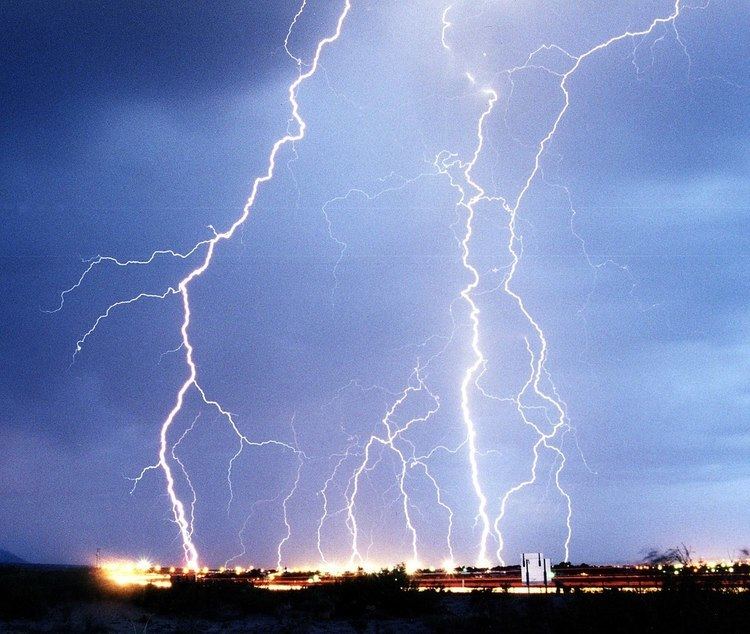Specialty emergency medicine ICD-9-CM 994.0 | ICD-10 T75.0 MeSH D015168 | |
 | ||
Lightning injuries are injuries caused by lightning strikes.
Contents
They result from three factors:
While sudden death is common because of the huge voltage of a lightning strike, survivors often fare better than victims of other electrical injuries caused by a more prolonged application of lesser voltage.
The treatment of lightning injuries is keraunomedicine.
Cause
Lightning can strike or injure humans in four different ways:
In a direct hit, the electrical charge strikes the person first. Splash hits occur when lightning jumps to a person (lower resistance path) from a nearby object that has more resistance, striking the person on its way to the ground. In ground strikes, the bolt lands near the person and is conducted by a connection to the ground (usually the feet), due to the voltage gradient in the earth. This can still cause substantial injury.
Electricity
Counterintuitively, lightning current flowing through the victim's body resistance may develop a high voltage sufficient to flash around the skin or clothing to the ground in a direct strike, resulting in a surprisingly benign outcome.
The lightning often leaves skin burns in characteristic Lichtenberg figures, sometimes called lightning flowers; they may persist for hours or days, and are a useful indicator for medical examiners when trying to determine the cause of death. They are thought to be caused by the rupture of small capillaries under the skin, either from the lightning current or from the mechanical shock wave. The intense electric current can cause a loss of consciousness; it is also speculated that the EMP created by a nearby lightning strike can cause cardiac arrest.
Heat
A bolt of lightning can reach temperatures approaching 28,000° Celsius (50,000° Fahrenheit) in a split second. This is about five times hotter than the surface of the sun. Spectacular and unconventional lightning damage can be caused by thermal effects of lightning. Hot lightning (high-current lightning) which lasts for more than a second can deposit immense energy, melting or carbonizing large objects. One such example is the destruction of the basement insulator of the 250-metre-high central mast of the Orlunda radio transmitter, which led to its collapse. The intense heat generated by a lightning strike can burn tissue, and cause lung damage, and the chest can be damaged by the mechanical force of rapidly expanding heated air.
Concussive injury
Just as heat can cause expanding air in the lungs, the explosive shock wave created by lightning (the cause of thunder) can cause concussive and auditory injury at extremely close range. Other physical injury can be caused by objects damaged or thrown by the lightning strike. For example, lightning striking a nearby tree may vaporize sap, and the steam explosion often causes bark and wood fragments to be explosively ejected.
Treatment
Reported mortality rates range from 10-30 percent, depending on the source of data. Most people who are struck by lightning live to tell the story, but many suffer from long term injury or disability.
Immediate
The most critical injuries are to the circulatory system, the lungs, and the central nervous system but injuries also occur to other body systems. Some victims suffer immediate cardiac arrest and will not survive without prompt emergency care. It is safe to administer care immediately, because the victim will not retain any electrical charge after the lightning has struck (of course, the rescuer could be struck by a separate bolt of lightning). Other victims may suffer myocardial infarction and various cardiac arrhythmias, most of which can be rapidly fatal as well. Loss of consciousness is very common immediately after a strike. Amnesia and confusion of varying duration often result as well.
Experiments on sheep show that a lightning strike to the head of a victim enters through the eyes, ears, nose and mouth, converging at the brainstem, which controls breathing. Many unconscious victims, who appear lifeless, actually die of suffocation. Chances of survival may be increased if cardiopulmonary resuscitation (CPR) is started immediately, and continued without interruption until the brainstem recovers.
Long-term
A complete physical examination by paramedics or physicians may reveal ruptured eardrums. Ocular cataracts may later develop, sometimes more than a year after an otherwise uneventful recovery. Long-term injuries are usually neurological in nature, including memory deficit, sleep disturbance, chronic pain, and chronic dizziness.
